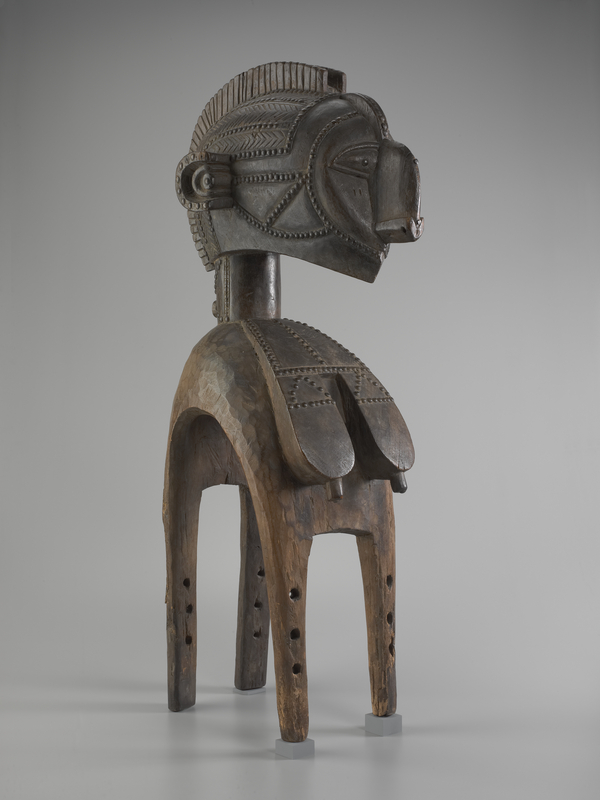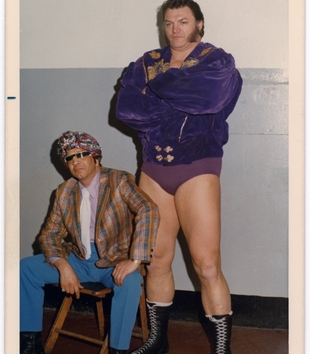What is the meaning of the word "spirit" in Africa? In my previous work among the Temne of Sierra Leone in the 1970s through 1980, I had intensively studied the spirits of the otherworld. All masked representations belong to that world of ethereal spirits and ancestors, and they form a sort of society, with husbands and wives, higher and lower ranks, and so forth. Getting along in the earthly world in large measure depends on how well one placates these more powerful beings.
When I came to the Baga, close linguistic relatives with the Temne, in neighboring Guinea in the 1980s, I brought the same set of questions. But what had worked so well with the Temne only baffled the Baga. There were clearly many spirits, both masked and unmasked. But there was one masked character, the most beloved, the epitome of all that is good, that defied definition—this is the character of D'mba, represented by an immense carved wooden superstructure worn on top of the head taking the form of a woman's bust resting on four legs. It is carried in dance by a very muscular young man concealed under a cloth and raffia costume. This figure appears in dance in the most sacred contexts: harvest, funerals, and weddings.
"Is D'mba a kàrfi, a spirit?" I asked them, assuming that it was. Absolutely not, they insisted; D'mba is not a "spirit" at all, neither ò-kàrfi nor ŋòŋk, the two categories of spiritual being. Educated Baga have all seen D'mba described as a "goddess" in the literature, and this is amusing to them and to their non-literate elders, who generally agreed that D'mba is simply an "idea," created by the Baga ancestors. Some of the defining characteristics are that it is for amusement, the dancer does not conceal his identity, and women and children can participate in the dance:
It is the ancestors who gave us this custom. The land was pleasing, but there was no amusement. So they said, "What shall we do to amuse the women and children?" Someone got the idea for carving D'mba. D'mba is not to-lom [sacred], because we dance it with the women. You can recognize the person inside. You see his feet (elder, Muslim, Tolkotsh village, Sitem subgroup, 1985).1
D'mba represented an abstraction of an ideal of the female role in society. She was the universal mother who was to be honored because she had born many children, and had nursed them to productive adulthood. She was the vision of woman at her zenith of power, beauty, and affective presence. She represented the Baga vision of goodness and light. Whether or not she was "sacred" is a point on which each Baga consultant has an independent view, but on this there is consensus: she was the invention of the Baga. This being said, I found repeatedly in my research among the Baga that, in their own view, they invent and construct their spiritual world, so invention of a character is not diagnostic of the profane.
Clearly this "idea" is something extraordinary. While not a spiritual being in the restricted sense that the Baga identify, and certainly not a deity, she remains a figure of spiritual power, as we would define that concept in the West. D'mba was endowed with enormous potential through her manipulation by Baga ritual specialists. Through the power of her suggestion engendered in ritual, young women gained the strength to bear children and to raise them to adulthood, the ancestors were encouraged to participate in the continuance of community well-being, rain was induced to fall, and the young men were driven to feats of cooperative excellence in agriculture.
In the example of D'mba and other masquerades associated with the creation of Baga society on the coast (as opposed to the traditions said to have been handed down from the Fouta Djallon Mountains to the northeast, the site of their mythical origin) we see an anthropocentric cosmological view in which the Baga create their own spiritual world. They are in charge, and if the spiritual world has power, it is because the Baga have chosen to allow it to be so.
© Frederick John Lamp
Notes
Notes
1. The Baga today are approximately 80% Muslim and 20% Christian. An Islamic Jihad in the 1950s forced the Baga to convert to Islam from their indigenous religion, and by 1960, all indigenous religious practices were declared illegal. Nevertheless, many Baga, both Muslim and Christian, express faith in the fundamentals of the Baga religion, even though they have abandoned most of the public practices.
Imprint
10.22332/con.obj.2015.1
1. Frederick John Lamp, "Mask with Superstructure Representing a Beautiful Mother (D'mba)," Object Narrative, in Conversations: An Online Journal of the Center for the Study of Material and Visual Cultures of Religion (2014), doi:10.22332/con.obj.2015.1
Lamp, Frederick John. "Mask with Superstructure Representing a Beautiful Mother (D'mba)." Object Narrative. In Conversations: An Online Journal of the Center for the Study of Material and Visual Cultures of Religion (2014). doi:10.22332/con.obj.2015.1



